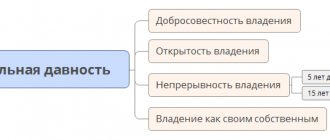Legal side
The right of common ownership of land plots refers to the types of private ownership of land and is characterized by a plurality of subjects of property rights, called participants in common property or co-owners, when using a land plot together (Article 244 of the Civil Code of the Russian Federation). In essence, the emergence of common property is the unification of subjects of land ownership and the connection of land plots into a single object, confirmed by an act of state registration. The right of common ownership of a land plot is divided into two types:
- General joint ownership of land (without determining shares).
- Common shared ownership of land (with determination of the shares of each co-owner).
The differences between the types of common property rights concern both the scope of the powers of the owners and the institution of the emergence of legal relations. Let us consider each type of common land ownership separately.
Use of public land in SNT
Usually the site is provided for temporary use free of charge. But in some cases, chairmen impose a certain social burden on the applicant. For example, they demand that vegetation be trimmed.
We recommend reading: Supreme Court Ruling No. 45-Kg16-27
When making decisions, the board will be guided by the interests and legal rights of the members of the partnership. For example, if an applicant plans to install a toilet or shower there, then he is more likely to be refused.
Common shared ownership of land
Common property can be declared shared property on the basis of an agreement between the participants in the common joint property or, in the absence of such consent, by a court decision (clause 5 of Article 244 of the Civil Code of the Russian Federation). Each of the participants in shared ownership has the right to receive ownership and use of a part of the land plot commensurate with the allocated share (Article 247 of the Civil Code of the Russian Federation). The powers of ownership and use of land, which is common shared property, arise on the basis of an agreement of all its property participants or by a court decision. A participant in common shared ownership who has carried out inseparable improvements to the common property (in this case, a land plot) using his own funds has the right to demand an increase in his share in the appropriate amount. If separable improvements have been made, they are the property of the participant in shared ownership who carried them out (Article 245 of the Civil Code of the Russian Federation).
The right of common shared ownership of land presupposes the distribution among all participants in appropriate shares of income, grown fruits and manufactured products entering the common property, unless otherwise provided by an additional agreement (Article 248 of the Civil Code of the Russian Federation). The costs of maintaining a land plot that is in common shared ownership are distributed among all participants in accordance with the size of their shares. In particular, each of the participants is responsible for the timely payment of land tax, submission of a tax return for land tax, payment of land maintenance costs, and more (Article 249 of the Civil Code of the Russian Federation).
A participant in common shared ownership has the right to dispose of his share at his own discretion, including, he can transfer his share as a gift or by will, or sell it under a land purchase and sale agreement. In turn, a land plot that is in common shared ownership can be disposed of only on the basis of an agreement of all parties involved. The alienation of a share of property in common property for a fee presupposes the preemptive right of the remaining participants to purchase the share being sold at the price in the amount at which it is being sold (Article 246 of the Civil Code of the Russian Federation).
Violation of the pre-emptive right to purchase a share gives the right to any of the participants in shared ownership to file a lawsuit within 3 months with a claim to transfer the rights and obligations of the buyer to him.
A land plot that is in common shared ownership and has the ability to be divided can be divided between all participants/co-owners who wish to carry out state registration of ownership of a separate land plot. Carrying out actions to divide the land involves the termination of common shared ownership of a given land plot, and can be carried out by common agreement of all parties or on the basis of a court decision (Article 252 of the Civil Code of the Russian Federation).
If it is impossible to separate a share by law or if the division entails disproportionate damage to property, the allocated owner has the right to demand payment to him of the value of his share by the remaining participants in the common shared ownership.
An owner who has received a sum of money or other compensation from the remaining participants in shared ownership for his share loses the right of ownership to his share in the common property.
An indivisible land plot, which is in common shared ownership, involves the payment of the cost of the share to a participant who wishes to allocate his share in kind by other participants (clause 3 of Article 252 of the Civil Code of the Russian Federation).
SNT Vinogradovo portal
Ø Features of registration
of common property/public land. The process of registration with the state cadastral register (hereinafter referred to as the GCU) and state registration of rights (hereinafter referred to as the State Register) of public lands in the SNT is carried out by the chairman of such SNT. Through a meeting and survey of all members of the SNT, a decision is made on the need to account and register public lands, after which they will become the property of the SNT as a legal entity. For the implementation of the State Civil Code and the State Register, the chairman, as a representative of the legal entity. The person turns to a cadastral engineer (either an individual entrepreneur or another legal entity of his choice) so that he prepares all the necessary documents . The process of surveying public lands will consist of a complete geodetic survey of land use and mandatory coordination of the location of the updated or newly formed boundaries of public lands with the owners of land plots that are part of the SNT. Most often, if there are a large number of SNT members, an announcement about such clarification of boundaries is published in a local newspaper or sent by mail with all the necessary details for feedback in case of objections. Also, it is always possible to hand over the Certificate of Approval for signature in person . In the event of objections arising when applying public lands to land plots of SNT members and vice versa, all situations are considered and resolved on an individual basis. In most cases, in practice, if land surveying has been carried out throughout the entire territory of the SNT, then the formed or clarified boundaries of public lands are established in accordance with the territory surveying project and directly along the boundaries of the land plots of SNT members already existing in the Unified State Register of Real Estate . In a situation where the boundaries of one or more plots are displayed incorrectly or erroneously (for example, there is an obvious overlap of the land plot of a SNT member on a common road), such boundaries are clarified after the prior consent of the owner. If such an overlay occurred due to a technical/registry error, then nothing will actually change on the ground for the owner of the “deleted” land plot. If the owner has seized/cut off a public territory, then, depending on various circumstances (consent of the chairman and all members of the SNT, maximum minimum/maximum sizes of land plots), he will have to either formalize this part or renounce it voluntarily or judicially .
Instructions for registration of public lands in SNT
The leaflet provides basic information on the procedure for establishing boundaries and registering rights to public lands in gardening partnerships.
General and regulatory information
Public areas - territories that are freely used by an unlimited number of people (including squares, streets, driveways, embankments, shorelines of public water bodies, squares, boulevards) (Town Planning Code of the Russian Federation)
Public property - property (including land plots) intended to provide, within the territory of a horticultural, gardening or dacha non-profit association, the needs of members of such a non-profit association for passage, travel, water supply and sewerage, electricity, gas supply, heat supply, security, recreation and other needs (roads, water towers, common gates and fences, boiler rooms, children's and sports grounds, waste collection areas, fire-fighting structures, etc.) (No. 66-FZ of April 15, 1998 “On gardening, vegetable gardening and dacha non-profit associations citizens").
The area of land plots to be classified as public property is determined in the amount of twenty-five percent of the area of garden or vegetable plots of land, determined according to the rules provided for in this paragraph.
As a rule, information about a land plot under public lands is contained in the Unified State Register of Real Estate as previously recorded. Such information was entered on the basis of a resolution on the allocation of land to a gardening partnership, a certificate of ownership (state acts) or a court decision on the provision of such land. In most cases, land certificates indicated the entire area under SNT allocated for collective gardening, without separately indicating the area of land common use. Also, the Acts contained diagrams of the plots provided.
The decision to carry out work to establish boundaries and register public lands of the SNT is carried out through a decision of the general meeting of all members of the SNT on the initiative of the chairman. If such a decision is made, the chairman has the right to contact a cadastral engineer, who may be an employee of a legal entity (for example, State Unitary Enterprise MO "MOBTI") or an individual entrepreneur to conclude an agreement for geodetic and cadastral work
Necessary documents for concluding a contract for cadastral works
To conclude an agreement to carry out geodetic and cadastral work to clarify the boundaries of public lands, the chairman of the SNT must prepare the following list of documents:
- Extract from the Unified State Register of Legal Entities
- Extract from the Unified State Register of Land Registration for a land plot for MNP
- General plan of SNT
- Powers of the chairman and details of SNT.
Scope of work
Geodetic work, desk processing of obtained measurements, preparation of a set of documents.
Geodetic work includes the visit of specialists to SNT for the purpose of conducting geodetic measurements on the ground, clarifying the boundaries, configuration and area of public lands.
As a result of desk processing of the obtained measurements, a diagram of the location of the land plot on the cadastral plan of the territory is formed.
The location plan is approved by the administration of the municipality. Based on the approved scheme, a boundary plan is prepared.
Simultaneously with the application for state cadastral registration, an application for state registration of rights is submitted.
Additional Information
If during the work, land plots unused by individuals - members of the SNT are identified, then the SNT makes a decision to carry out work to establish the boundaries of these plots. The future fate of these areas is decided by SNT itself.
When surveying land and registering property in the cadastral register, you can now get a discount.
On May 17, the “Union of Summer Residents of the Moscow Region” and the Moscow Regional BTI signed an agreement, thanks to which summer residents of the Moscow region will be able to receive discounts when surveying land and registering property for cadastral registration.
“Today the Union of Summer Residents of the Moscow Region and MOBTI entered into a cooperation agreement. This is an important step for us, because summer residents and gardeners in the Moscow region need a reliable partner, because some of the main issues that concern summer residents are surveying, imposing boundaries, and their coordination. Today, in MOBTI, we have found a real partner. In addition to this partnership, we have also agreed on discounts that will be provided to summer residents and gardeners, so we recommend that the entire gardening partnership apply collectively. Firstly, it will be much cheaper. Secondly, it is systematic, thanks to which you can avoid imposing boundaries and multiple coordination with neighbors. This day is significant for summer residents and gardeners of the Moscow region, because now we are confident that land surveying will be carried out efficiently and inexpensively,” said First Deputy Chairman of the Moscow Regional Duma, Chairman of the Union of Summer Residents of the Moscow Region Nikita Chaplin.
“The Union of Summer Residents helps gardeners in a wide range of issues. The Moscow Regional BTI is ready to be a reliable partner in solving problems related to real estate. As part of cooperation, we will jointly hold events, advise citizens, and provide up-to-date information on the website of the union for registering dachas and land plots. The Moscow Regional BTI is a state enterprise with extensive experience and a large archive of data on real estate objects. We have a wide branch network: 69 points throughout the Moscow region. Special promotions are already in place for gardeners and will continue to be developed. For example, a discount on services when registering a house and land at the same time. And of course, it is most beneficial for summer residents to contact us as a whole company. It will be cheaper and faster,” MOBTI General Director Alexander Bednyagin told reporters.
The agreement between the “Union of Summer Residents of the Moscow Region” and MOBTI began to operate from the moment it was signed; its goals are also to increase citizens’ awareness of the legal regulation of land and property relations in the Moscow region, to provide assistance in the preparation of documents for registration of rights to horticultural real estate, gardening and dacha non-profit associations of citizens and their members.
Source: Summer residents of the Moscow region of the Russian Federation.
Common joint ownership of land
The right of common joint ownership is regulated by Art. 253 of the Civil Code of the Russian Federation, according to which all participants in this legal regime can jointly own and use common property (land), unless otherwise provided by an additional agreement. A land plot that is in common joint ownership can be disposed of by any of the participants, with the consent of all other parties. For example, the procedure for owning, using and disposing of farm land is determined by an agreement between persons who have expressed a desire to create and operate a joint farming enterprise.
At the same time, the authority to dispose of a farmer's land plot is given to its head in the interests of running a farm. Each of the participants in joint ownership has the right to enter into various transactions to dispose of the common property, while the completed transaction may be declared invalid on the basis of claims made by other participants regarding the lack of certain powers of the party who made the transaction. The division of common property between the participants in joint ownership or the allocation of the share of one of them is carried out after the preliminary determination of the share of each of the participants.
The division of common joint property requires equal shares for all participants (Article 254 of the Civil Code of the Russian Federation).
The legal regime of common joint property is clearly described in Art. 256 of the Civil Code of the Russian Federation (common property of spouses). Thus, property acquired by spouses during marriage is their joint property, with the exception of certain cases provided for in the marriage contract. At the same time, property that was acquired by one of the spouses before marriage or received as a gift or by inheritance during marriage is his property. Based on Russian legislation, joint ownership arises in relation to:
- peasant farms;
- common land plots that were acquired through targeted contributions from members of gardening and dacha non-profit partnerships;
- common property of the spouses, unless otherwise provided by the marriage contract;
- joint ownership of citizens who are members of gardening and dacha non-profit associations, subject to the provision of a land plot on payment terms.
Privatization of public land in SNT
The collected documents are submitted to the cadastral chamber of the district administration to register the land plot and assign it a cadastral number. There are no other ways to unambiguously identify a plot of land; a general cadastral plan for gardening is not a basis for assigning cadastral numbers to individual plots without carrying out land management work on each of them. Most likely, you mean the privatization of public land in SNT.
We recommend reading: Required Details Checks From July 1, 2019 Reporting
Secondly, public land in gardening partnerships and garage cooperatives includes roads, driveways, lands on which power lines, gas pipelines, pipelines, reservoirs, utility structures (gatehouses) are located, that is, everything that is located on the territory of SNT or GSK , with the exception of land plots directly assigned to citizens.
State registration of common shared ownership of land
A property located on an undivided plot of land can be acquired under the right of common shared ownership or lease with a plurality of persons on the lessee's side, taking into account shares in the ownership of the building. To acquire the right of common ownership of a land plot, all parties involved must jointly apply to the state local government body with applications for the acquisition of ownership rights to a land plot (Article 245 of the Civil Code of the Russian Federation); a cadastral passport of the object must be attached to the applications.
Features of privatization of land in SNT
Next, you will need to draw up a geodetic and boundary plan. When all these documents are collected, you can contact the Cadastral Chamber, submit an application and pay the state fee for entering the necessary data into Rosreestr.
- law of 2001 (provides free privatization of land plots to citizens who became their owners before the Land Code of the Russian Federation was adopted);
- law on “Dacha Amnesty” of 2006 (extended until March 2019);
- a number of amendments to the main act dated 01/01/2015 (simplify the main scheme).
Privatization of public land in SNT
Lawyer's answer to the question: privatization of common lands in the SNT; this property is the property of all members of the SNT and its privatization is not necessary. This property should be on the balance sheet of the organization ———————————————————————— I have been using a plot of land from public land (PLL) in SNT since 1993.
In addition, only the redistribution of these lands into the private ownership of SNT members will not allow the local administration of the urban settlement of Povarovo to withdraw these as being used for other purposes and transfer them, for example, for rent to businessmen, in the event of further annexation of SNT "Solnechnoye" to the lands Mikhailovka village.
We recommend reading: Maternity capital cash issuance in 2019






